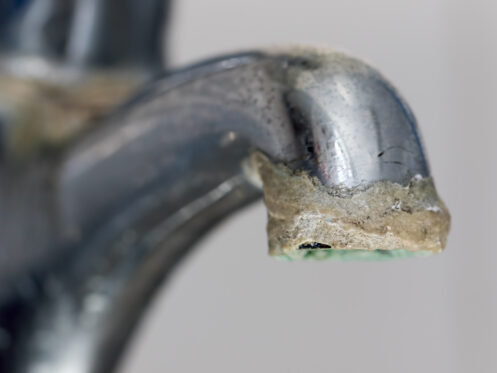Hard water doesn’t look different when it comes out of the tap, but it can leave a heavy mark behind that you can’t see. Inside your pipes, faucets, and water heater, minerals like calcium and magnesium cling to surfaces and slow things down. Over time, this buildup can clog lines, reduce equipment life, and escalate small plumbing issues into major problems. At Pacific Plumbing & Rooter Inc, in Eugene, OR, we’ve helped homeowners deal with hard water headaches from slow drains to struggling appliances.
Scale Buildup Inside Your Pipes
Hard water brings in minerals like calcium and magnesium that don’t fully dissolve. When that water moves through your plumbing, these minerals start to stick to the inside of the pipes. At first, it looks like a light film. But as you keep using that water, the buildup thickens. Pipes that were wide and clear when they were installed become narrower, kind of like arteries with plaque. That narrowing affects the way water flows.
You may notice water pressure dropping, or a faucet that used to run strongly now trickling. It’s not always something you can see from the outside, but inside the pipe, the space shrinks and the surface gets rough. That roughness creates friction, which slows things down even more. In older plumbing systems, this buildup can lead to complete clogs or force pipes to work harder than they should, increasing wear.
Shorter Lifespan for Water Heaters
Your water heater doesn’t just store hot water. It also becomes a holding tank for whatever comes through the line. When your home has hard water, those minerals settle to the bottom of the tank. They form a crusty layer that traps heat and throws off the temperature settings. The heater runs longer, trying to push through that sediment. That constant cycling creates heat spots on the tank, which can warp the metal or damage the heating element.
You might notice inconsistent water temperature or strange noises, like popping or rumbling, when the heater runs. Those sounds come from water pushing through mineral piles. Once buildup starts, it usually doesn’t go away without draining or flushing the tank. In tankless systems, minerals coat the heat exchanger, which reduces efficiency and can burn out the unit early. Either way, your equipment gets worn down faster than expected.
Faucets and Fixtures Wear Out Faster
Any spot where water flows out, like faucets, showerheads, or sprayers, gets hit directly by mineral-heavy water. These parts collect deposits quickly, especially in joints and tight spots. You might see white crust forming around the spout, but the damage isn’t only what you can see. Inside the fixture, those minerals collect around the valve seats and washers. As that grit builds, it stops the seals from sitting flat.
Water starts to leak, even if the faucet is closed tightly. That leads to drips, wasted water, and higher bills. Cleaning the outside helps the look, but inside, the minerals keep working away at the parts. Washers crack. Threads get rough. Moving parts jam or start squeaking. You replace a fixture, and it happens again within a year. It’s not bad luck, it’s the water.
Soap Doesn’t Lather and Leaves Behind Residue
You might not expect plumbing problems to show up in your laundry or dishwashing routine, but hard water changes the way soap behaves. The minerals in the water bind to soap molecules, stopping them from forming a good lather. Instead of getting a full foam, you get weak bubbles that don’t clean well. That means you use more detergent just to get the same effect.
After rinsing, the leftover minerals can leave a film on dishes, clothes, and even skin. This buildup can coat the inside of your washing machine or dishwasher, affecting performance. Inside those appliances, mineral residue settles around the seals and water lines. Over time, this can block the jets, dull your glassware, or trap bacteria in the folds of rubber gaskets. These issues don’t just annoy you, they make the machines work harder and shortens their useful life.
Toilets Can Start to Struggle
Hard water doesn’t skip the toilet. Inside the tank, minerals build up along the sides, around the flapper, and inside the fill valve. When that buildup gets thick enough, parts that are supposed to move freely start sticking. You might flush and hear the tank take longer to fill, or the water might not stop running. Inside the bowl, the rim jets, those tiny holes where water flows down, can clog up with scale. That leads to weak flushes or strange swirling patterns.
You scrub the bowl and think it’s clean, but the problem sits higher up where you can’t see it. These clogs don’t just make flushing less effective. They also keep the bowl from emptying fully, which leads to staining and odor problems. Replacing the affected parts might help for a while, but the same thing will keep happening if the mineral problem stays.
Dishwashers and Washing Machines Lose Performance
Both of these appliances rely on clean water movement and good drainage to work properly. When minerals coat the heating element or spray arms in a dishwasher, dishes come out cloudy or spotted, even with rinse aid. You might hear it working louder than before, or notice a damp smell after the cycle ends.
In a washing machine, hard water changes how well detergent dissolves, which means your clothes might not rinse clean. Residue builds up inside the drum and hoses. That sludge can trap bacteria or mildew and shorten the lifespan of the machine. You might also notice stiffer fabrics, faded colors, or detergent that never thoroughly rinses. If these symptoms creep in across both machines, your water quality might be the common link.
Leaky Joints and Fittings Can Form
Hard water doesn’t just harm the fixtures you use daily; it also causes problems in the joints and fittings that hold your plumbing together. Mineral buildup creeps into threaded connections or places sealed with rubber gaskets. As the buildup grows, it pushes parts apart slightly or breaks the seal. A slow drip begins and can turn into a bigger leak if left alone. These spots are often hidden under sinks or behind walls, so the leak might not get caught until water damage shows up.
Moisture seeps into cabinets or drywall, and by the time you spot the stain, the repair involves more than just plumbing. Mineral deposits also act like sandpaper against moving parts. As water pushes the grit through fittings, it grinds down surfaces that are supposed to be smooth, causing more leaks and faster wear.
Water Pressure Can Get Out of Whack
As scale builds inside the pipes, it doesn’t just affect water volume. It changes the way pressure works throughout your home. You might notice intense pressure in one bathroom but barely a trickle in another. That’s not just a random glitch; it’s a sign that the lines feeding those fixtures aren’t the same anymore. Narrowed pipes force water to speed up in some places and slow down in others. In a shower, this might mean bursts of pressure followed by sudden drops. These uneven flows can cause parts to rattle or wear unevenly.
Save Your Plumbing From Hard Water Damage
You don’t have to live with hard water damage or keep fighting those stubborn stains on your own. There are ways to protect your plumbing and give your water system a fresh start. We also offer water softener installation, pipe descaling, and plumbing inspections. Whether you’re starting to notice signs or you’ve been dealing with years of mineral buildup, Pacific Plumbing & Rooter Inc can help you clear things up.







